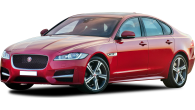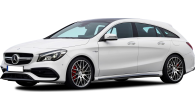Like technology trailblazers which came before it (and which it so clearly seeks to emulate) like Apple with the smartphone as we know it today, or Dyson with its stick vacuum, Tesla is the poster company for vehicle electrification.
It's undeniable the effect the brand has had on the global car market, forcing storied automaker's hands in proving full scale production (even though it might be rocky at times) of an electric-only car is not only possible, but it can be profitable and popular, too.
Which brings us to the Model 3. Following on from the successful but expensive Model S sedan and Model X SUV, the Model 3 promised to be an accessible, affordable EV for the masses, a proper people's car for the electric era.
So, has Tesla managed to achieve this? Or, is slick EV motoring at a reasonable price still a pipe dream for every-day motorists? We tested the Model 3 for a week to find out.
_1.jpg)
Tesla Model 3 2021: Long Range AWD
| Engine Type | 0.0L |
|---|---|
| Fuel Type | Electric |
| Fuel Efficiency | 0.0L/100km (combined) |
| Seating | 5 |
| Price From | $73,810 - $84,810 |
| Safety Rating |
|
Does it represent good value for the price? What features does it come with?
Which Model 3 are we testing, you ask? Currently in Australia there are three options. The Standard Plus, Long Range Dual Motor, and the Performance.
Our car was the mid-grade Long Range Dual Motor. The dual-motor moniker just means it has the electric version of all-wheel drive, and Long Range indicates this is the one with the biggest battery, with an estimated range of 580km, according to the Worldwide Harmonised Light Vehicle Test Procedure (WLTP).
You'll note straight away this much range is unrivalled by pretty much any other EV on the market right now, but it comes at a cost.
_0.jpg)
This red car we tested wears a drive-away price of $93,549, with an MSRP of $86,325. Tesla provided a rather helpful breakdown of all the costs involved, making special mention of all the taxes you're slugged with if you buy one, specifically in NSW.
$7224 of on-road costs or not, the MSRP is still a far-cry from the affordable accessible electric car I bet Tesla wanted the Model 3 to be. To be fair here, you can get into the rear-wheel drive Standard Plus from an MSRP of $66,900 (or a smidge over $70k on-road, 430km WLTP range) which can bring the cost down a little.
It's a significant price-leap from non-premium competitors like the MG ZS EV ($43,990) and the Nissan Leaf ($49,990), though neither can come anywhere close to the Model 3's stellar range capacity.
A more reasonable direct rival, then, is the Hyundai Kona EV (from $60,740) which is competitive on range, too (449km WLTP).
The Long Range as tested here has 19-inch alloy wheels, 12-way power adjustable front seats, with heated seats all-round, clad in vegan leather, premium 14-speaker stereo (actually great), that huge 15-inch tablet floating in the centre which serves as both the multimedia interface and instrument cluster, full LED exterior lighting, a panoramic glass roof, heated auto-folding wing-mirrors, and a surround camera suite.
_0.jpg)
The safety stuff in this car is... unconventional, but we'll get to that in the Safety section of this review, and Tesla backs that huge screen with sim connectivity which it needs for various key features like the excellent phone app and built-in streaming services.
A very welcome dual wireless phone charging pad appears under the screen, which helps keep its slick interior wire-free.
The car also has more than its share of gimmicks which deserve a mention, like theatre mode, and being able to draw doodles on the screen and play mobile games while the car is parked and what not.
_0.jpg)
Wholly unnecessary, but if you've got kids they'll love it, plus the theatre mode is handy if you often spend time waiting behind the wheel.
Interestingly, the Model 3 has no CarPlay connectivity with the brand betting you'll use built-in versions of popular streaming apps.
You can also pre-set the nav using the Tesla app, but I found it a bit annoying being unable to browse my iPhone's music library easily, even though it can stream audio and calls via Bluetooth.
_0.jpg)
Is there anything interesting about its design?
I think what's most interesting about the Tesla's design is the lack of it. The brand has really leaned into the whole clean aesthetic which sticks it to the car industry by making a feature of the fact this car requires no grilles or intakes, and intentionally steers clear of wings, highlights, and garnishes to leave a clean silhouette, as though the car was shaped by liquid.
A recent update even deletes the American-style chrome garnish around the window frames, in favour of an even more subdued matt black.
This approach adds further transparency to the fact that the inspiration behind this car is more from the world of tech products than it is from the existing codex of automotive design.
Elements remain though, mere suggestions of the influence of low-drag sports cars in that Porsche-style bonnet.
Massive 19-inch alloy wheels, perhaps the one element of a car that Tesla cannot stray from, finish the design with a brilliant silver highlight piece and are now clad in quieter, more efficient Korean Hankook rubber.
As always with Teslas, it gets even the more interesting on the inside. The minimalist tone is rammed home, the Model 3's cabin feeling less like a car and more like a piece of avant-garde furniture.
There's no instrument cluster, buttons, climate unit, nothing, just a clean line running across what is left of a dashboard, swooping into the nexus of that central screen.
To reinforce its eco nature, there's a highlight strip of open pore wood to break up the strong darkness of the panel work. Even door handles have been removed, with a simple button built into the door handles, with a backup release hidden underneath. Tidy.
_1.jpg)
Tesla makes sure to mention its interior materials are "vegan", with tasteful application of faux-leather seats, as well as faux-suede highlights in the doors and wireless charging bay.
While complaints echo across print and the internet of shoddy finish on Teslas, or perhaps the fact that they are 'premium' on price alone, I was truly taken aback by our test car.
Soft-touch trims extend well beyond where you'll commonly come in contact with them, the console plastics have a sturdy feel to them, with the only weak spot being some slightly misaligned headliner trim above the rear seats.
On the whole, though, if this car had an established premium badge on its wheel, I wouldn't be disappointed with the quality of the surfaces or finishes.
The same can be said with the exterior, with the only notably amiss shut lines being the ones around the boot lid which I could almost fit my fingers in. The rest of the car was well within what I'd consider a reasonable tolerance.
_1.jpg)
How practical is the space inside?
Although Tesla has gone with an overtly minimalist approach to its interior, there are still plenty of places for your belongings. This is largely to do with the fact that the Model 3 needs to make no concessions for traditional running gear under its floorplan.
A clear example is the centre console design, which has two massive storage areas, one running under the charging bay, and another under the armrest console.
There are also useful tubs in the doors with large bottle holders, a small glove box, which oddly can only be opened through a button on the touchscreen, a set of large central cupholders, which annoyingly have no adjustable edges, and the aforementioned dual wireless charging bay for phones.
The seating arrangement proved adjustable with pre-set profile options selected through the screen for the wheel and mirrors.
There are parts of this car's design, however, which are straight-up flawed from a practicality perspective. No hard shortcut buttons for anything might look nice but adjusting key features through tiny touch elements on a huge screen is hardly intuitive when you're meant to be keeping your eyes on the road.
_1.jpg)
The same goes for a lack of an instrument cluster. Having to look away from the road just to check your speed isn't the best. I do think this could easily be solved by offering this car with a holographic head-up display. Why not? It costs nearly $100,000 and there's already so much tech in it.
All of this is a reminder that the Model 3 is more about turning a car into a Silicon Valley tech product than it is about using its inherent electrified benefits to turn it into the ultimate pragmatist's form of personal transport.
That said, the software in the Model 3 is beautiful. Operating this car is no different from using a cutting-edge smartphone, it's revolutionary in the same way going from a flip-phone to an iPhone was but really shouldn't be. We're in the future now, this is the way interacting with a car should feel in 2021.
The back seat offers decent room for a car of this size, but I was a little disappointed given how much room should be afforded by its EV underpinnings.
_1.jpg)
While the lack of a transmission tunnel (normally required to facilitate rear- or all-wheel drive in a traditional car) is a huge plus, especially for adults using the centre seat, there's not as much room as I expected elsewhere.
My knees had a little bit of airspace behind my own driving position, but my head was very close to the roof pillars on either side of that huge panoramic glass panel.
The comfortable and soft trim continues to the rear seats and doors though, so while it's a tad tight for someone my height (182cm/6'0") it's still comfortable, and rear passengers benefit from dual adjustable air vents (which seriously push out some cold air, easily as strong as the front vents), and there are also two USB-C ports for rear passengers to charge from.
Storage space comes in the form of small pockets on the backs of the front seats, large bottle holders in the doors, and a set of smaller bottle holders in the drop-down armrest. The rear row features dual ISOFIX child-seat mounting points on the outer two seats.
_0.jpg)
The boot is interesting. For this year, Tesla has added a motorised tailgate, and available space comes in at 425 litres. Keep in mind though, this includes the large under-floor storage area, which we needed to use to fit the whole CarsGuide demo luggage set.
_0.jpg)
The lack of a traditional engine in the Model 3 means its front also opens up to a so-called "frunk" which has a quoted capacity of 117 litres. I was happy to find that this comfortably fit our smallest (36-litre) CarsGuide demo case.
_0.jpg)
What are the key stats for the engine and transmission?
The Model 3 has no engine, just motors hidden away on its axles. This version has two, hence the 'dual motor' in its name.
Both are hugely powerful, more than most petrol cars at this price could hope to be, and with the confidence of fully digitized torque delivery it's astoundingly confident, too.
Tesla won't offer official figures for the Model 3's motor outputs (I assume so we can't compare them to rivals for whatever reason), but with a 0-100km/h sprint time of 4.4 seconds suffice to say acceleration in this thing is sledgehammer brutal.
How much fuel does it consume?
Fuel? None, but the Model 3 can store a ton of electricity in its huge battery. Again, Tesla, for whatever reason, won't tell us the usable battery capacity in kWh to use as a comparison, leaving us only with the range to go off, and it's very impressive.
With 580km of range to play with, the Model 3 reaches beyond the bounds of 'range anxiety' and into the realm of competitive week-long ranges of combustion vehicles.
_0.jpg)
All of that is no consolation if it takes a day or more to charge your vehicle, which it can if you're stuck with a wall outlet.
Tesla is betting you'll rely on its supercharger network though, and I'll admit it does make things easy.
The Model 3 is equipped with a single charge port, a European-standard Type 2 Combo CCS charger, which can be used at Tesla supercharger locations or public outlets.
Use of both networks is a huge plus, giving Tesla owners an unrivalled choice of charging locations, at least up and down Australia's east coast.
_0.jpg)
Charging on DC at fast charging locations is impressive, with the Model 3's maximum charge speed at 250kW. This allows for charge times as forgettable as a grocery run.
At my nearest supercharger (120kW) for example my Model 3 charged from 25 – 90 per cent in about an hour. Anxiety free around a city indeed. Perhaps less so if you lived or frequently commuted regionally. Even 50kW fast chargers are a relative rarity.
When it comes to AC charging locations things are good, too. Tesla offers quite a few of these locations (less infrastructure is required), usually at the max AC speed of 22kW. Unlike the Model S and X, however, the Model 3's AC inverter is just 11kW, so that will mean longer charging times.
_0.jpg)
For reference I did one charging session from my local Tesla AC location and it added about 75km of range in an hour. Tesla says to charge off of a wall outlet you can expect just 10km an hour to be added, meaning it would take an eternity to charge this car from your garden-variety ~2kW wall socket.
Charging using Tesla's network is no longer free as it was in the first few years of the brand's presence in Australia, but it's still more affordable than filling up with petrol.
_1.jpg)
The Model 3 has an official/combined energy consumption figure of 13.1kWh/100km, while on our test of largely urban commuting the car used 17.1kWh/100km.
While you might not have much of a reference-point for that, it's about right for a car this size. You can expect its luxury rivals to consume beyond 20kWh/100km, while the very good Hyundai Kona consumed 14.1kWh/100km when I tested it in similar conditions.
_1.jpg)
Warranty & Safety Rating
What safety equipment is fitted? What safety rating?
To get a maximum mark in this category, a car has to do a lot of things, but for me it has to actually move the safety envelope forward from the status quo and add something new. I think the Model 3 actually does that.
Instead of a regular itemised suite of safety equipment, the Model 3 builds a picture of the world around it using an unprecedented sensor array consisting of 360-degree visual camera coverage, forward facing radar with 160 meters of range, and 12 ultrasonic surround sensors.
You have the confidence of seeing how the car visualises this through a radar-like display which takes up a portion of the screen while the car is in motion.
It not only detects objects, vehicles, people, cyclists, and traffic markers, but can even categorise vehicles by type (you'll see trucks, sedans, and pickups fly past you in the car's 'brain') and uses its visual-spectrum components to alert you when a nearby light goes green.
_1.jpg)
Auto emergency braking – or whatever this car's equivalent is – works from 10km/h to 150km/h, and the infamous 'Autopilot' mode is included which is a step beyond active cruise control; the Model 3 is capable of steering, changing lanes, and basically doing the whole thing for you. Of course, with controversy in international markets, the car now requires that you hold the wheel every so often to stop you from relying on it entirely.
With regulations the way they are I can hardly recommend the full-self driving upgrade (a crazy $10,100 option at the time of writing) which upgrades the software to let the car pretty much perform the whole drive experience based on a destination set in the navigation, complete with stopping and going at the lights, overtaking slower vehicles, and full automatic parking and summoning.
As this is a software upgrade, Tesla even lets you purchase the option long after you've acquired the car but warns the price will increase as the software is improved.
The expected airbags are present, as are dual ISOFIX and three top-tether child seat mounting points across the rear seats.
_0.jpg)
The Model 3 was tested by ANCAP in 2019 and scored a maximum five-star rating, with one of the best-ever scores across ANCAP's four categories.
One thing I will flag with the Model 3's safety is to take extra caution around pedestrians. I spent some time on my week stuck behind pedestrians walking down alleyways who had no clue I was there without me rudely sounding the horn. A drawback of all-electric motoring, but some competitors have had the forethought to make their electric cars emit some sort of sound.
What does it cost to own? What warranty is offered?
Tesla has rolled back what used to be an eight-year warranty to four-years and 80,000km for the whole package, which includes roadside assist. Still a little behind the expected industry standard five-year promise, but ahead of some rivals at the premium-end.
The battery pack is covered by an eight-year/192,000km warranty to boost your confidence in this car's running gear.
_1.jpg)
As there are far fewer moving parts in a Tesla, the servicing is computer determined on how the vehicle is driven. The brand itemises individual items that may need attention, like brake pads and fluids, wiper blades, as well as air-conditioning filters, and the system informs users when a 'service' is required. Tesla also performs tyre changes and wheel alignments, none of which are outrageously priced.
What's it like to drive around town?
In some ways the pure electric drive of the Model 3 is radically different from standard combustion cars, but in other ways it's familiar. The layout won't be a shock to anyone (apart from that missing instrument cluster), but the way in which the car's key characteristics can be significantly altered via software alone could come as a shock.
The steering feels entirely artificial, with three modes to select. I found the default comfort setting to best suit this car's serene character, with the sport and even normal modes feeling rock-hard in comparison.
The feedback from the accelerator, too, can be varied, with the default mode preferring regeneration, allowing the car to act essentially as a single-pedal vehicle. It will come to a full stop as you let your foot off, maximising the amount of regained energy.
Too different for you? You can remove this function entirely, or even make the Model 3 behave like a car with a 'normal' transmission, and have it lurch forward at the lights when you take your foot off the brakes.
You can even adjust this car's acceleration, which by default is sledgehammer fast and ultra-responsive. The 4.4-second 0-100km/h sprint time capability becomes suddenly and vividly real with even a half-prod of the accelerator, but a 'chill' mode can be activated to smooth it out even further for those so inclined.
Tesla can even change all of these attributes via over-the-air updates which really gets you thinking about how much of this car exists in the real world and how much of it exists only in cyberspace.
_0.jpg)
One thing that can't be changed via update is the suspension tune which many consider to be firm to a fault. In my week of driving though I didn't notice this as much as I thought I might. Make no mistake, there are moments best described as 'brittle', especially at low speeds over ruts or corrugations, but when it comes to larger bumps the car is more forgiving.
The Model 3 uses its weight to its advantage, by slinging the batteries low in the chassis, and the fully independent suspension conspires with the entirely-computer-based all-wheel drive system to make for ridiculous cornering prowess. Even under heavy acceleration, torque distribution is cleverly and instantaneously controlled so you barely hear a chirp out of the tyres.
It doesn't quite have the romance or mechanical feedback of a car with a combustion engine, but its undeniably capable.
The cabin is ultra-quiet as well, adding to the futuristic overall drive experience. It is annoying to have to look away from the road to control this car's key functions, but the ability to monitor and receive important updates about your surroundings easily via the radar screen is a brilliant addition.
While cabin noise does take a bit of a jump at freeway speeds, the autopilot functions are neat. They are perhaps the best in the business (again, another thing Tesla has a head-start on over its rivals), but still had moments where they are imperfect.
While the car can all but drive itself (it will chide you for taking your hands off the wheel) the lane change feature proved a tad swervy, and when it does ask you to take control back the wheel can 'unlock' in a bit of a dramatic way.
After getting used to all the little conveniences and luxuries this car offers though, it's hard not to look at other cars a bit differently. Despite some minor flaws, the Model 3 makes you wonder why more of its rivals don't feel as slick and effortlessly capable.
_0.jpg)
Verdict
I wasn't sure what I'd make of the Model 3 going in. I've heard all the stories, read all the reviews, but to really analyse it for a week was eye-opening.
Yes, it has its flaws: It's a far cry from affordable or accessible, it has some small usability blunders and unnecessary gimmicks you wouldn't expect from more mainstream rivals.
However, the interconnectedness and technology in this car adds a real-world gadget-like convenience which is an undeniable revolution from what car owners usually put up with. It's backed by an unrivalled range and sleek drive experience which really cements Tesla as still, by far, the king of electric cars. Only time will tell if the brand can bring the price down with future versions.
Pricing Guides








.jpg)

.jpg)
















.jpg)

.jpg)



.jpg)